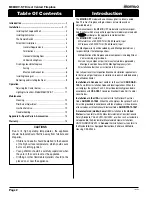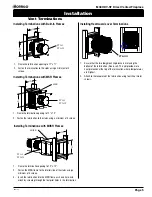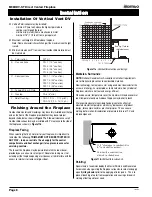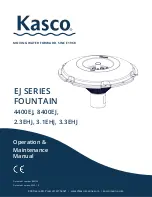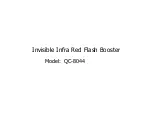
XG0128
Page 12
M38ODV-ST Direct Vented Fireplace
Maintenance
General
Have the fireplace installation inspected yearly, including a visual
check of the vent system, the burner and the pilot flame. For your
convenience a 1/8" manifold pressure tap is supplied on the gas
valve for a test gauge connection. See Figure 16.
For
Natural Gas
this appliance requires a minimum inlet pressure
of 5.5" W.C. and a manifold pressure of 3.5" W.C.
For
Propane Gas
this appliance requires a minimum inlet pressure
of 11" W.C. and a manifold pressure of 10" W.C.
Always keep the fireplace area clear and free of combustible
materials, as well as gasoline and other flammable vapours and
liquids.
Do not use this appliance if any part has been under water.
Immediately call a qualified service technician to inspect the
appliance and to replace any part of the control system and any gas
control which has been under water.
CAUTION
•
Fireplace gas control must be in the “OFF” position and pilot
and main burners extinguished when cleaning appliance with
a vacuum.
•
Glass and logs can get very hot. Handle only when cool.
Cleaning
When the fireplace is first activated, there may be some smoking and a
visible film may be left on the glass. This is a normal condition, and is
the result of burningthe protective coatings on new metal.
Glass must be cleaned periodically to remove any film (a normal bi-
product of combustion) which may be visible. Film can easily be
removed by removing the door, as shown on page 9. Handle the
door carefully, and clean it with non-abrasive glass cleaners. One of
the most effective products is Kel Kem.
Silicone seals on inner door during initial firing will "off gas", leaving
a visual deposit of a white substance on combustion chamber walls.
This can easily be removed by following the steps described above.
Use a vacuum cleaner or whisk broom to keep the control compart-
ment, burner, and firebox free from dust and lint.
Logs may be cleaned periodically with a vacuum to remove soot.
WARNING:
Do not attempt to clean glass when hot.
Do not clean glass with abrasive materials as any glass
etching may cause premature glass failure.
Pilot Burner Adjustment
1.
Locate Pilot Adjustment Screw.
(See figure 16.)
2.
Turn Adjustment Screw until flame is proper size.
(See figure 17).
3.
After installing or servicing, leak test with a soap solution with main
burner on. Coat pipe and tubing joints, gasket etc. with soap
solution. Bubbles indicate leaks. Tighten any areas where the
bubbles appear until the bubbling stops completely.
Gas Control Valve
Figure 16.
Sit Nova 820
gas valve for M38ODV-ST.
Manifold Pressure
Test Connection
Pilot Adjustment Screw
Inlet
Pressure
Power
Generator
Wall Switch
Figure 17.
Pilot Burner.
Troubleshooting
Continuous Pilot System Troubleshooting
The following is a troubleshooting chart of possible problems:
PROBLEM
CORRECTIVE ACTION
Noisy Pilot Flame
Locate Pilot Adjustment Screw. Flame
is decreased by turning adjustment
screw clockwise.
Pilot won’t ignite
Disconnect remote wires and try to
light pilot. If pilot now works, remote
connections are faulty. Check wiring
diagram
figure
16.
Main burner will
1. Check wiring
(see figure 16)
not light
2. Check wall switch for proper
connection.
M38ODV-ST


